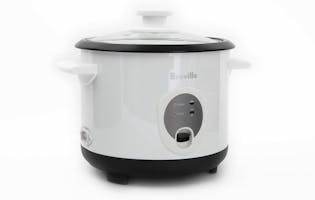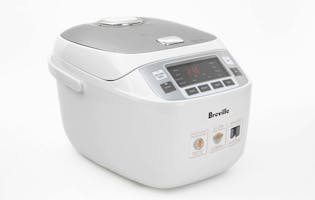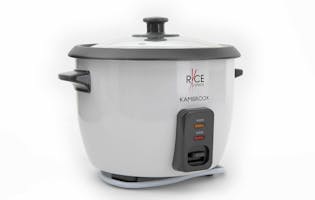Rice cookers
If you eat a lot of rice, you might want to invest in a rice cooker.
A set-and-forget rice cooker is a convenient way to cook rice. It’s also an easy fix if your rice often clumps.
How a rice cooker works
The heating element gently brings water to a boil. Once the rice has absorbed the liquid, the cooker switches to warming mode. If you put your rice on early, it’ll be ready to use when you’ve finished making the rest of your meal. Rice cookers are great for families who eat at different times too.
Do you need one?
If you eat a lot of rice, a rice cooker may be a worthwhile buy – it’s the easiest way to cook rice. But you can get good results on a cooktop or in a microwave with a bit of practise.
Cooktop
Cooking rice via the absorption method can be tricky. You need to know exactly how much water to add for the rice you’re cooking. You’ll need to bring it to the boil, then reduce it to a simmer until all the water’s absorbed. If your pot doesn’t have a tight-fitting lid or is permanently vented, you might need to add extra water since moisture will be lost through evaporation.
You also need to watch that your rice doesn’t stick to the pot and burn, especially near the end of cooking when most of the water’s absorbed. A small amount of burnt rice can taint the whole batch. And burnt-on rice can make your saucepan difficult to clean.
Alternatively, you can cook rice via the rapid boil method. This involves boiling the rice in a larger amount of water, then draining off the excess when it’s cooked. But the rice can lose some nutrients in the discarded water. And it can be tricky to strain the rice so it’s dry enough without letting it cool down too much.
Microwave
You can also cook rice in a microwave with a microwave-safe jug or bowl. But, as with the cooktop absorption method, you need to know how much water to add for the rice you’re cooking. And you might need to experiment with cooking times, depending on the strength of the microwave.
Rice cooker features
Consider these features when you’re buying a rice cooker.
Capacity: Think about how much rice you’ll cook at a time. Larger models can cook up to 10 cups of uncooked rice; smaller cookers about 5 cups. Larger cookers also take up more cupboard space.
Extra cooking functions: Some models have specific cooking functions to sear, steam or slow cook, or to make porridge, cake or bread. Some have specific settings for different rice types, such as brown, jasmine, sushi or sticky.
Lid: A sealed lid stops liquid splattering out, but they can be fiddly to clean, even if they have a removable inner lid. The lid on some cookers can’t be removed for cleaning. Glass lids let you check on progress without interrupting cooking. But they can rattle and be difficult to clean.
Timer: A timer will alert you when cooking is done. Only some rice cookers have one.
Suction feet: These will prevent your rice cooker sliding on the bench when pressing controls and keep it safely in one spot.
Removable cord: A removable cord allows you to take the cooker to the table for serving. It also makes the unit easier to store.
Accessories: Most models come with a spoon, a measuring cup and a steamer tray.
Check our test results to see which models have the features you want. We also note which ones can get dangerously hot.
Which brand is most reliable?
We ask thousands of Consumer members about their products to find out which brands are most reliable and satisfying to own. The results are available to members and Digital Pass holders.

People's Choice
Our People's Choice awards are granted to brands that consistently rate above average for customer satisfaction and meet out other performance criteria. Become a member and see which brands have earned a People’s Choice award.
We've tested 8 rice cookers.
Find the right one for you.


